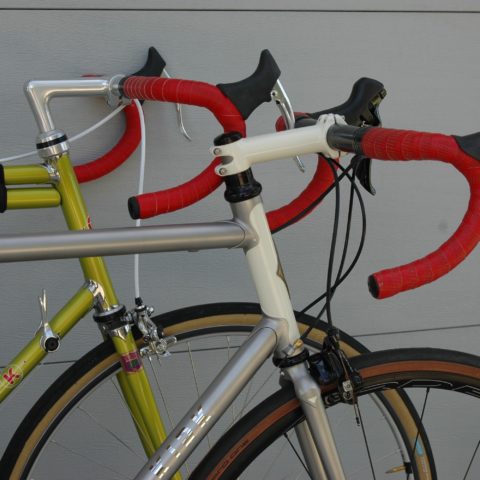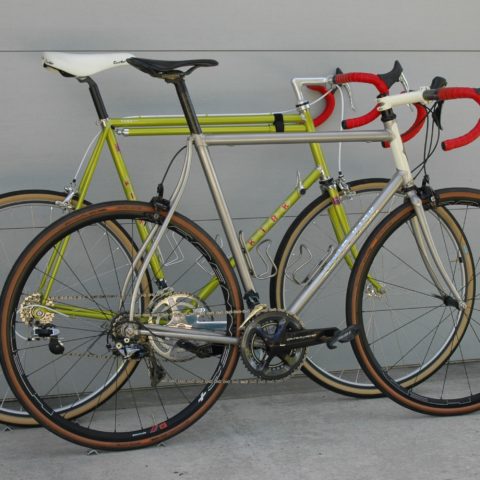753 vs. 953
753 vs 953
When I started working at Serotta in 1989 there were many types of tubing to choose from…hearing that a bike was built of Columbus SLX or Reynolds 531 sounded good but there was one tube that really spoke to me – Reynolds 753. There was something special and mysterious about 753. It was thin, light, exotic, and exclusive – one needed to pass a brazing test to get “certified” to work with Reynolds 753. There weren’t many 753 certified builders in the USA so it made it a rare thing here.
I took my 753 test in 1990. I don’t recall how long it took to get the results but it felt too long. When the certificate finally showed up in the mail, I was pretty damn pleased. My step father framed it for me and I have it to this day. I was 27 years old.
Being freshly 753 certified I had to build something special with this super tubing. I decided to build a road bike with stainless steel Henry James lugs, BB, fork crown, and dropouts. Nothing but the finest. I built the frameset after-hours and was shocked by how light it was for a frame my size (63 x 61). I custom cut the lugs into curvy flame-like shapes and fabricated the seat stay caps into overly intricate shapes. When done I polished the stainless lugs, BB and crown to shine like chrome. Now it just needed paint.
I proudly marched it into the paint shop at Serotta and brought a case of beer (the usual cost of an after hours paint job) and the boys looked at me like I was nuts. Once they saw the carved lugs and fussy masking required a case of beer was far from enough. So, I brought it home with the idea that I’d mask off the lugs myself and get it sprayed later. I put it on a hook in the basement for safe keeping. It ended up staying there for 30 years.
Flash forward to the year 2003. I’d started my own framebuilding business in Bozeman, MT. The 753 bike hung unpainted, unloved, and never built or ridden in the basement while I worked with more modern materials up in the garage. Just a few years into the new business I started working with the current super tube – Reynolds 953. Like 753 it was light and thin and exotic. I incorporated it into my JK Special model (and later the all-stainless Onesto) and built hundreds of them over the years. To this day I smile when picking up a 953 tube and revel in how light it is. The thing that is different about 953 is that the material is so strong that the tubes can be made thinner than anything else while still being tough enough to last a lifetime.
Flash forward one more time to 2020. I wanted to attend the Cino Heroica vintage bike ride in Kalispell, Montana on a proper vintage bike but I certainly couldn’t buy any old bike off eBay. I needed a bike that I built myself. That’s when the Cino 753 bike plan was hatched. I scoured the webbernet for vintage Mavic parts (my personal favorite) and in time I had everything needed. I assembled the frame into a bike, still unpainted, and rode it. I then realized that for Cino I’d need a bigger tire than the 23’s bike was designed around so I took the brake bridge out and moved it up so that the pads would just barely reach the rim in their lowest position. I then removed the front dropouts and replaced them with a taller dropout (making the fork longer) to give the needed tire room. I could now just squeeze 32 mm tires under those tiny short reach Mavic calipers. I rode it more and when satisfied pulled it apart and sent it off to my painter Joe Bell. JB masked and painted it in resplendent Legnano Green and I rode it a few hundred miles before taking it to Cino. Aside from two flats on chunky gravel at the Cino the bike performed perfectly.
With all the time I spent on the 753 bike I noticed I was riding it differently than I did my modern bike. It was subtle but unmistakable…I pedaled and steered in a different way and I wanted to understand how, and why.
After Cino I rode the old 753 and my modern 953 bikes back-to-back for a few weeks and the thoughts and feelings started to crystalize in my head and legs. This made me want to compare and contrast how these two different bikes, from two different eras, each made of the then current cutting-edge tubing, would feel out in the road.
Now I’ll say this upfront – this is not an engineering study. I didn’t hook strain gauges up to each bike and ride with a computer to analyze the data. Instead, I rode each bike and noted about how they felt and what type of riding they rewarded. I cruised, hammered, climbed, and descended on my everyday paved and dirt roads and listened to what the bikes each told me.
Another caveat – the Cino 753 bike was assembled with vintage Mavic components while the modern Kirk 953 has current 11 speed Shimano Dura-Ace parts and wide HED wheels. Both leading edge stuff in their times and yet very different today. These parts influence the way the two bikes ride as a whole and that can’t be dismissed. This comparison is really of two complete bikes, from two different eras.
First, we need to talk about the tubing. I won’t burden this with lots of numbers but suffice it to say that the material used in 953 tubes is nearly twice as strong as the 753 material. Where this really comes into play is with the ability to make the tube walls thinner. The two materials weigh the same but 953 is so much stronger that it can be made much thinner…and this in turn makes the tubes lighter and smoother riding. A 753 down tube has butted walls of .8/.5/.8 while a 953 down tube has walls of .55/.35/.55. That’s a big difference.
Another place the tubes differ is their diameter. The 953 tubes that I use on a bike my size are much larger in diameter than was used back when 753 was king. The 753 top tube is 1” in diameter while the 953 top tube is 1 1/4”. This makes a massive difference in both bending and torsional stiffness. The 953 tubes end up being lighter than the 753 even though they are larger in diameter and much stiffer at the same time.
So how does it feel to ride them? First the 753 bike. This bike, with its small diameter and flexi tubes, is a magic carpet ride. It is smooth in a way that needs to be felt to be understood. It soaks up road buzz and expansion joints like they aren’t there. It rewards riding in a smooth and controlled way. It feels out of its element when you stand and hammer at 100%. I feel best on the 753 bike when riding at a slightly lower rpm – spinning quickly on it starts to give it a bouncy and unsettled feeling. I find that I stay seated on climbs where I normally rise out of the saddle and use a smaller cog. Going down fast descents gets your attention. That 61 cm long 1” top tube is not stiff and the head tube tends to wander at speed. You guide this bike down hills – you don’t attack them. In a much smaller (and therefore stiffer) size maybe you could give it the beans, but not this one. I feel a bit slower on this bike while climbing but a lot slower descending. It’s day-and-night. That said it’s really fun in its own way. I like it for easy “day-off” rides where I just want to feel the sun on my face for an hour. I would not want to race this bike…I would have in 1990 but having sampled what modern material can provide I know that I’m much slower on the older 753 bike.
The 953 bike – If I get off the 753 and immediately climb on the 953 bike it’s shocking. The 953 bike still has that wonderful steel smoothness going down the road but it also feels like it’s machined from billet. The lack of twist between the head tube and seat tube gives it a security the 753 bike can’t match. It feels all of one piece and like it’s goading the rider to pedal harder and faster all the time. It goes downhill like it’s on rails and doesn’t need any gentle guiding. At the risk of personifying the bike – it likes to be hammered on. On rough dirt roads it will hold whatever line you want and won’t get pushed off it. Even on rough sections of dirt you can reach down for a bottle and not feel like something bad is going to happen since it holds a line so resolutely. It loves to be ridden hard out of the saddle and sprinted. In short, it’s a race bike to its core. And yet due to the thin tube walls it retains that wonderful springy and resilient ride steel is known for. If I could race myself on each bike the 753 bike wouldn’t know which way the 953-me went. It’s that different.
All of this brings to mind the conversation I’ve had countless times over the past 20 years. I’ll be talking with a fellow rider and they will say “I owned a Pinarello back in 1985 so I know how steel rides.” and my thought is always the same…you know how a 1985 steel bike rides and a current steel bike is a world different. I get that many see steel as a “mature” material that hasn’t changed over time…I get it, but it’s wrong. No one would dream of saying a carbon or Ti bike built decades ago would ride the same as those built today and steel is no different. The technology and metallurgy have advanced in a massive way over time and it sells current steel, or stainless steel, bikes short. Even the heralded 753 can’t stand up to modern materials and that is saying something big.
Thank you for reading.
Share this Article:








Leave a Reply
You must be logged in to post a comment.